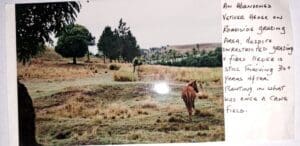Vetiver enhances soil moisture.


Measuring soil moisture:

Last week I received a couple of photos of soil moisture readings from a farm at Marsabit, (northern Kenya). There had been no significant rainfall since 2023, the most recent was in December 2024, and that was insufficient. These two images show the percentage of soil moisture (measured in mid-March 2025) at about 20 cm depth. Next to the vetiver plant moisture was 40% and further away on bare soil 20%. This may help to explain why tree seedlings and other perennials grow well in close association with vetiver. The farmer, Somo Abdul Kahbir, plans to place some permanent markers at various distances from vetiver hedges and use them for repeated soil moisture measurements over the year and at different times throughout the seasons in order to get a better picture of the impact of vetiver hedges on soil moisture
Using a moisture meter can help to better understand the effectiveness of vetiver. This particular model: “Gain Express Soil PH and Soil Moisture Sensor Meter” has a sturdy 30 cm probe and measures both soil moisture and pH (Available on Amazon) and has a reputation for accuracy..
Somo Abdul Kahbir, besides being a farmer, is a volunteer administrator of TVNI’s social media platform on Facebook and an administrator of the Vetiver in Kenya Facebook group does a great job. Thank you Somo.


Vetiver’s growth under dry conditions in Vietnam.
Vietnam farmer – Phuong Nguyen, a young woman who has embedded vetiver into her farming practices posted this short video comparing her green vetiver based farm with her neighbors dry farm (the upper part of this photo).
Companion planting with Vetiver
Peter Kingori from Kenya writes: There is no doubt that our farmers are quickly adopting the companion planting of vetiver and their crops. The results are amazing. I can imagine the Biomass they will get. The biomass will provide entry point towards non-tillage regenerative systems that will greatly reduce expenditures and inputs (labor and chemicals where used).
Vetiver food forest and honey production
It all started with vetiver – Caleb Omolo from Rongo, Kenya is a leader in regenerative agriculture. He practices what he preaches. His 3 acre food forest that was developed on eroded land reclaimed with vetiver produces various products including coffee, mangoes and hard wood. It has also become a bee sanctuary. He writes: “My Food Forest has just naturally turned into a bee sanctuary. I started with 2 brooder boxes and two supers but now the bee colonies have multiplied to 40 hives and still more colonies are breaking away The good thing is they don’t fly far. They just


settle on a near by trees inside the forest it makes it easier for me to put catcher box to trap them and bring them back to the apiary. My food forest has become a sanctuary for beneficial insects. Caleb provides high-quality queen bees to members of the Kenya vetiver group.”
Caleb provides high-quality queen bees to members of the Kenya vetiver group. He demonstrates how small farmers can maximize productivity and improve soil and ecology on limited land. Organizations in East Africa needing training in regenerative agriculture should consider Caleb’s training services.
We are seeing many variations of vetiver linked food forests often with multi-layers of species. Some useful on farm experimentation could be undertaken to look at various management practices and plant varieties, and the trade off between tree/plant density and the light requirements of vetiver (vetiver appears to survive 60% shade (Yoon).
Vetiver longevity: Thirty year old vetiver hedgerow

This photo taken by John Greenfield in 1986 shows a 30 year old hedge (center) that has survived and grown well despite grazing and fire. In fact fire probably enhances vetiver growth through the removal of dead leaves etc resulting in greater light penetration for new growth at the center of the clump. I have viewed many satellite images of vetiver in Fiji and it is pretty clear that where hedgerows have been maintained by one means or other their longevity is assured. In this case originally established on a cane field where it would have been well maintained assured a good to start to allow long term growth in an area that was used as pasture – grazed and burnt.

The image below shows a long vetiver hedgerow on Ano Farms, Ethiopia where vetiver is a permanent feature within a rotation of maize and pasture.
Development aid funding cuts:
The withdrawal of USAID funding will effect many developing countries and is likely to disrupt important agricultural development initiatives particularly in Africa and Asia. The cuts will, amongst others, disrupt programs that are designed to secure agriculture and food production in the face of climate change. Food insecurity and vulnerability to climate shocks will increase.
Key challenges include:
Reduced Access to Resources: Farmers face difficulties in accessing improved seeds, fertilizers, and modern farming techniques, which were previously supported by USAID programs.
Disrupted Supply Chains: The withdrawal of funding will affect the distribution of agricultural inputs and market access, leaving many farmers unable to sell their produce or obtain necessary supplies.
Economic Strain: The local economy, particularly in rural areas, will be hit hard as agricultural projects and related employment opportunities are scaled back.
Increased Vulnerability: Without aid support, the agricultural sector is more vulnerable to climate shocks and other external challenges, potentially exacerbating food insecurity.
The reduction of aid funds may have a silver lining in making countries and communities at local level less dependent on foreign aid, turning to local sources and resources instead. There are opportunities for community based development supported by volunteers using proven low cost sustaining technologies. Vetiver Grass Technology fits well this scenario in that it provides opportunity for expanding “autonomous adoption” of a technology that is near perfect for supporting community and farmer needs in addressing soil and water issues. Autonomous adoption is defined as a process of independently incorporating or utilizing something—like a technology, system, or idea—without requiring external intervention, supervision, or regulation. In this context, “autonomous” emphasizes self-sufficiency or independence.
Promoting vetiver as an autonomous adoption practice
When promoting vetiver as an autonomous adoption practice to communities that under reduced availability of aid receive are likely to get even fewer support services the following points should be highlighted:
- Understanding Vetiver Grass Technology: Vetiver Grass Technology involves the use of Vetiver grass (Chrysopogon zizanioides) for soil and water conservation, erosion control, and land rehabilitation. Known for its deep root system, Vetiver grass can stabilize soil and prevent erosion, making it an ideal choice for various agricultural applications (and non-agriculture uses too). The grass is also highly tolerant to extreme weather conditions, pests, and diseases, further enhancing its suitability for adoption in diverse environments.
- Soil Conservation and Erosion Control: Erosion is a critical issue in agriculture, leading to the loss of fertile topsoil and nutrients essential for crop growth. Vetiver grass, with its extensive and deep root network and when applied as a contour hedge/barrier, can effectively anchor soil, reducing erosion by up to 90%. This stabilization not only preserves soil fertility but also enhances water infiltration, promoting healthier crop growth. By implementing VGT, farmers can maintain productive land, even with limited financial support.
- Water Management: Water scarcity and inefficient water management are major concerns in agriculture, exacerbated by funding cuts. Vetiver grass plays a vital role in water conservation by reducing surface runoff and increasing water retention in the soil. Its deep roots can tap into underground water sources, improving the resilience of crops during drought conditions. Additionally, Vetiver hedges can be used to create natural barriers, directing water flow and preventing flooding in vulnerable areas.
- Economic Viability and Cost-Effectiveness: One of the significant advantages of Vetiver Grass Technology is its cost-effectiveness. Once established, Vetiver grass requires minimal maintenance and can thrive without expensive inputs such as fertilizers and pesticides. This makes it an attractive option for farmers facing financial constraints due to funding cuts. The initial investment in VGT is relatively low, and the long-term benefits, including increased crop yields and reduced soil degradation, reduced costs of farm inputs, provide a high return on investment.
- Improving Crop Yields: Vetiver grass not only protects the soil but also enhances its fertility by increasing organic matter and promoting beneficial microbial activity. This improved soil health translates into higher crop yields, which is crucial for farmers adapting to reduced financial support. By utilizing VGT, farmers can achieve better productivity and food security, even in the face of economic challenges.
Community and Environmental Benefits

Beyond individual farm benefits, Vetiver Grass Technology offers broader community and environmental advantages. The reduction of soil erosion, improved water/rainfall management, applications to protect community infrastructure and water supplies all contribute to the overall health of the ecosystem and the people who live and depend on it. Moreover, VGT can be incorporated into community-based projects, fostering cooperation and shared knowledge among farmers. Training programs and workshops on Vetiver grass cultivation can empower local communities, making them more resilient to funding fluctuations. This recently published training manual (download) by Robinson Vanoh of Papua New Guinea provides excellent material for training communities.
Challenges and Considerations
While Vetiver Grass Technology offers numerous benefits, its adoption is not without challenges. Farmers may require initial training and technical support to effectively implement VGT. Additionally, there may be resistance to change, particularly in communities with traditional farming practices. Addressing these challenges through education and demonstration projects is essential for the successful integration of VGT into agricultural systems.
To conclude, Vetiver Grass Technology presents a viable solution to mitigate some of the negative impacts of aid funding cuts in the agricultural sector. Its ability to conserve soil, manage water, and improve crop yields offers significant advantages for farmers facing financial constraints. By promoting the adoption of VGT, policymakers and development organizations can support sustainable agriculture and enhance the resilience of farming communities. As we navigate the challenges of reduced funding, innovative and cost-effective solutions like Vetiver Grass Technology are crucial for ensuring the continued growth and stability of the agricultural sector.
The role of proven and seasoned small private sector enterprises
To fill the technology gap likely to result from aid reduction small vetiver based companies could support the development of autonomous adoption at community level. Here follows two examples (and there are more) of vetiver companies that are impacting communities in the South Pacific Islands and the Caribbean.

Robinson Vanoh – Managing Director and owner/founder of Eagle Vetiver Systems Ltd., Papua New Guinea.
Robinson Vanoh transitioned from oil palm plantations to founding Eagle Vetiver Systems Ltd., (mentored in part by TVNI’s technical director, Paul Truong). His early work in PNG, starting around 2010, is detailed in this presentation at ICV5. This link takes you to Robinson’s interesting postings on TVNI Facebook. He also administers the Pacific Islands Vetiver Community Based Network Inc. He is a board director of TVNI.
Robinson is committed to his community, excels as a trainer and adviser/technical expert, and correctly applies vetiver technology using quality plants. Collaborating with TVNI and UNDP/South Pacific University, he has revived the technology across most South Pacific Islands. See: Promoting and dissemination of information about vetiver system technology applications across the South Pacific islands and accompanying presentation describes his role in the promotion in the South Pacific Islands..
Robinson is truly a role model for anyone who wants to set up a vetiver based company and to use the company to solve some of the many environmental problems that face both small and large communities, as well as meeting the demand by the commercial and industrial sectors for green solutions for the stabilization of infrastructure and for pollution mitigation. There are other vetiver based companies in many tropical countries that are active vetiver businesses, many of them could support community vetiver based initiatives.

Jonathan Barcant and his company, VetiverTT, located in Trinidad and Tobago, West Indies
The company provides a range of vetiver services and needs for the private and community sectors in a number of the Caribbean islands. Amongst others,TrinidadTT provides technical support and leadership to the community driven IAMovement projects (excellent website – comprehensive and interesting). The IAMovement has been a game /life changer bringing younger people into the business of environmental improvement.
Jonathan is a civil engineer specialized in soils, water and environment and through this has led much of IAMovement’s technical project development and implementation activities to date, importantly relating to the organization’s work with vetiver grass and the Vetiver System (VS), through the now widely tried and tested Vetiver Education & Empowerment Project (VEEP) model which Jonathan originally co-developed with a colleague, friend and community member from Paramin, Jaime Romany. Jonathan also led and co-led the development of many other projects and initiatives in the education and public awareness spaces of IAMovement such as the Climate Talks programme, REthinking Energy video series, and other educational videos and films over the years.
Jonathan is also the founder of the green engineering company Vetiver TT Ecological Engineering Solutions Ltd, and co-founder of House of Vetiver Ltd and Close The Loop Caribbean Ltd. He holds similar Board level, technical and guiding roles in these organizations, which are all regenerative, community and environment-supporting in nature, and work alongside IAMovement for the implementation of relevant projects and activities all aligned to IAMovement’s overarching goal of effecting positive social and environmental change, in Trinidad & Tobago and beyond. He is a TVNI Board member.
Vetiver related social media platforms
The updated list of vetiver-related websites, Facebook, Instagram, and other sites is available at this link. Some sites may be inactive but might be revived!. We encourage those interested in vetiver to join existing groups or create new ones to share information about vetiver and its uses. Small WhatsApp groups, Facebook pages, or dedicated websites can all be helpful. These platforms provide valuable information for users of all types including businesses. Some of the existing groups have played vital roles in the development of new applications. To add a new group or site to the list, please email TVNI’s Webmaster
Change of TVNI webmaster
We are pleased to announce that Daniel Londono of Australia (English and Spanish speaker) has kindly volunteered to take over webmaster responsibilities for TVNI’s website. He has many years of vetiver field experience in both Australia and Colombia, and was responsible for organizing the second regional Latin America Vetiver conference. He has a deep commitment to vetiver and its future development. Please contact him at [email protected] if you want to share information or make suggestions for website improvements. Daniel is in the process of setting up an organization, Vetiverse, to “To empower individuals, communities, and governments worldwide to create sustainable environments by providing access to cutting-edge research, educational resources, and a comprehensive database of Vetiver grass knowledge. To advance the understanding, application, and accessibility of Vetiver grass solutions globally”
Daniel takes over from Man Tran (Vietnam). We wish to thank him for his support and work as webmaster for the past 5 years.
Richard Grimshaw
Thank you for your leadership, Dick! As you mentioned, there are silver linings. Every example of “autonomous adoption” that occurs during this time of… U.S. retreat from global engagement, will provide conclusive proof that vetiver technology is “scalable”, sustainable, and a great option for development funding by governments and other organizations that want to address a range of issues related to the climate crisis in concrete and cost-effective ways. It will be a distinct pleasure to see the scalability and sustainability non-issues consigned to the ash heap of history.
Thanks also to both Man Tran and Daniel Londono for their outstanding work on this website. It is clean, intuitive, comprehensive and easy to use.
Peace to you all,
David
I would like to have knowledge about this grass